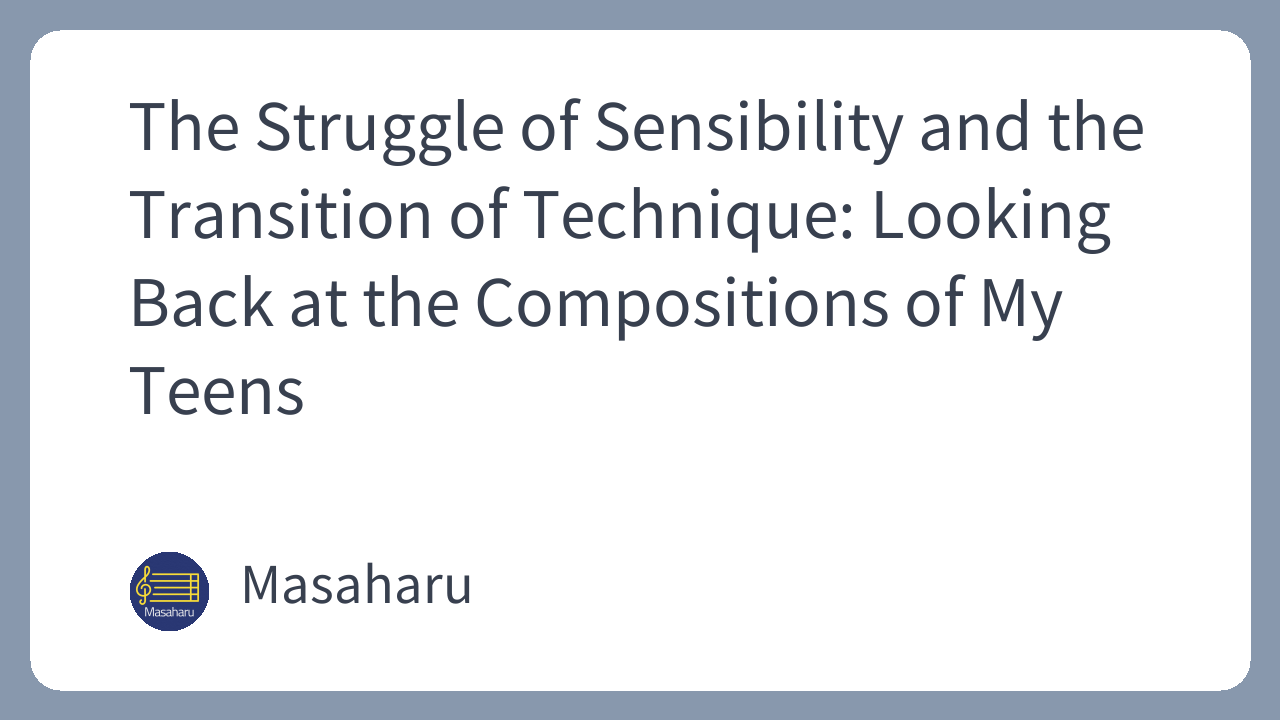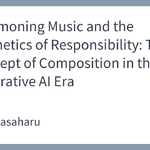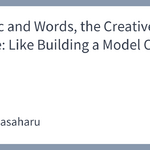In this article, I’d like to look back on my composing style and creative attitude from my teenage years by listening to the works I composed back then.
This will likely be a personal and nostalgic reflection, but I’ll be writing about what kind of music a person who had just started composing was making, against what background, and with what feelings. I hope you’ll join me.
About My Very First Song (Composed in 1987)
I completed my first original piece of music in the winter of 1987, at the age of 14, when I was in my second year of junior high school. I composed it on an NEC PC-8801FH computer using a music programming language called MML (Music Macro Language).
Unfortunately, the audio source no longer exists, but it was a piece played entirely with an “FM synthesis bell-type sound with a long decay,” and it resonated like an adagio for a string ensemble.
The composition depicted a journey from silence to a peak of resonance, before returning to silence once more. Within a slow, deliberate flow, like the striking of a bell, the volume gradually increased. It was a piece of several minutes that progressed bit by bit, repeating simple cadences and modulations that suggested an ascent.
I remember being sensitive to musical harmony (the sound of chords and modulations) since I was a child, and I can see that this “preference” was naturally woven into the very first song I created.
After that, I continued using the PC-8801FH and the X68000, manipulating their FM (plus PCM) sound sources with MML to create original songs and covers of video game music.
Then, at 16, I acquired the MIDI instruments I had longed for and stepped into the world of professional music production (sequenced music).
The works I still have in my possession are from 1989 onward, after I started producing music with MIDI instruments at the age of 16.
So, from here, I would like to pick out five characteristic pieces from the music I composed between the ages of 16 and 19, and reflect on them while listening to the original sound sources.
Please note that the audio sources included here have undergone some light mastering using EQ, compression, and other effects.
‘Icy Hands’ (Composed in 1989)
This is a work from when I was 16 (a sophomore in high school), produced using the KORG M3R, which had just been released at the time. The sequencer (what we now call a DAW) was the MML environment on an X68000, which had a MIDI expansion driver installed.
This is one of those songs where I, inspired and influenced by the game music and fusion I loved at the time, tried to give shape to my own “tastes” while imitating them.
The rhythm is borrowed from metal rock, and the harmony is based on a minor key, evoking the image of “majestic and heroic game music,” which I painstakingly tried to spin together, however clumsily.
The structure, which modulates with each section, and the approach of trying to absorb the gap of those modulations with the melody line, are both fascinating to me even now. They reveal both the “exploratory stance” and the “honest adherence to my own senses” of that time.
Around this time, I had only just begun to learn chord theory, so I wasn’t yet able to apply it to composition or use it for analysis. But in return, I was able to concentrate on composing while earnestly confronting my own sensibilities.
Later, as I became more proficient in music theory and various techniques, this early internal clash, which could be called a “struggle with sensibility,” temporarily disappeared from my sound.
This song is neither stylish nor sophisticated; it has a rough, unrefined feel. But it’s a memorable piece that makes me reflect deeply, knowing it was a work I could only have created at that age. (I was fond of the chorus in this song, so I used it again years later in ‘Behind’.)
The mix is in a typical “bathtub reverb” state, which makes me chuckle at my own beginner status. I remember being so happy with how rich the reverb made everything sound that I tended to overuse it.
This piece isn’t quite as bad, but it’s characteristic of this period that many song titles are rather strange. For example, a song from the same time called ‘Kink Nail’ literally translates to “Twisted Nail.”
The background to this was an embarrassment about giving titles that were too faithful to my mental image, so I deliberately chose words that didn’t make much sense. Thinking back on my state of mind then, it makes me smile.
Also, the “KORG snare drum,” which I would continue to use for some time after this, evokes a strong sense of nostalgia. It was such a characteristic and memorable snare drum that anyone familiar with MIDI instruments from that era would immediately recognize it as “Ah, that KORG sound.” (The KORG piano sound was also very distinctive.)
Incidentally, this snare drum was also used for the PCM drums in the X68000 version of the game ‘Bosconian,’ so it must have been a familiar sound to X68000 users as well.
‘Final Takeout’ (Composed in 1990)
This piece is from when I was 17 (a senior in high school), created a few months after ‘Icy Hands’ using the same KORG M3R.
The “shyness about titles” I mentioned with the previous song is evident here as well. The title is a play on the Sega game music track ‘Final Take Off,’ but it’s a name that makes me feel the folly of youth, thinking, “Surely not ‘The Last Takeaway’.”
Now, in this track, the harmonies suddenly became much cleaner. This shows that, for better or worse, I was becoming accustomed to chord theory through my studies.
The song structure is also based on popular music, following the common structures seen in fusion instrumental music, and closes with a fade-out on the chorus refrain.
From a bright major-key intro, it smoothly transitions into a somber minor-key A-section. Just as you think it might return to the major key at the end of the A-section, it continues in the minor key. This shows my attempt to deepen the listener’s impression by clearly coloring the entire piece with the shading of major and minor.
It was composed by weaving in techniques I had grown accustomed to using, such as borrowed chords from the parallel minor, the Picardy third, and cliché lines. However, because my proficiency was skewed towards chord theory, at first listen, it almost feels like a “score of just chords and melody” before any arrangement has been applied.
This demonstrates my limitations at the time; arrangement techniques were completely missing. At the same time, I was utterly captivated by the “transitions of chord voicings,” and my past self would probably say, “I just wanted to hear the sound of the naked chords resonating.”
In that respect, this song is characteristic as it succinctly expresses my composing posture at the time.
‘Hard Worker’ (Composed in 1991)
This is a work from when I was 18, after I had started working. It was produced using the X68000’s internal FM sound source, a Roland MT-32 and U-220, a KAWAI K4r, and the M3R. The sequencer used was the MML environment on the X68000.
By this time, I had begun to clearly aim for fusion-style music, mixing in influences from game music, and attempting to express my own version of a “band sound” through sequencing.
I was particularly focused on the bass. At the time, I was obsessed with the chopper (slap) bass playing of bassist Yoshihiro Naruse, and I featured chopper bass in many of my works. This song also kicks off with a chopper phrase right from the beginning.
The melodies and ad-lib phrases were inspired by my favorite game music, but I struggled to shape them with good taste, and I feel they retained a certain “earthiness” or lack of refinement.
But this, too, was something only I could have written at that specific time, and it was undoubtedly an authentic representation of my music.
It’s also true that while I was composing freely like this, I was beginning to feel a vague sense of falling into a rut.
Even when composing this song, I had the feeling that I was “making it too easily” (in a bad way), and I felt that although the form was solid, it lacked “passion and heat.”
From another perspective, one could say that a “template” for this kind of music was forming. However, because of that underlying sense of dissatisfaction, I didn’t pursue this direction to a breakthrough. Instead, I found myself treading water for a while, moving back and forth.
Another tendency seen in my works from this period is the lack of “push and pull” (dynamics) in the arrangements.
In other words, all the parts were always playing in the same way, lacking contrast. Every part was always “trying hard” to be heard, resulting in a state where no single part stood out.
This was likely the result of neglecting the “topography” of the overall sound—the contrast between sparse and dense textures—driven by an obsessive feeling that I “couldn’t stand situations with few notes.”
Regarding the song title, it seems that by this time, the embarrassment or shyness I felt about naming songs had faded, and I was able to be more direct.
I believe the reason for this was the budding of a certain pride as a composer. I realized that joking around to hide my shyness was itself “uncool” and an irresponsible act that showed contempt for the listener.
‘Suita Junction’ (Composed in 1991)
This is a piece from when I was 18, created with the same instrument configuration and sequencing environment as the previous song, ‘Hard Worker’.
This song was composed during a period when my inclination towards fusion music grew even stronger, and the direction of “reproducing a live performance through sequencing” became clear.
Perhaps as a result, the “flatness of arrangement due to an over-reliance on chord theory” that was present before seems to have been somewhat resolved. However, because I was still preoccupied with designing harmonies, it appears I wasn’t able to capitalize on the creative possibilities that should have been there.
To put it positively, one could argue that by placing myself under a certain constraint (harmony-centric), I made it easier to express unexpected creativity.
In any case, in this track, the tendency towards flatness in the arrangement is slightly suppressed. You can hear an attempt to create contrast in the space and thickness of the sound, using phrasing that evokes a live performance.
Thinking about it now, perhaps I was also struggling with various aspects of arrangement at the time. Instead of recklessly layering sounds or increasing the number of notes, I might have been trying to fill the music with the inherent persuasive power of the phrases themselves.
Incidentally, the title of this song was taken from the “Suita Junction on the Meishin Expressway” in Osaka Prefecture. I had in mind the image of cars trafficking through this famously congested spot. I must have been strongly attracted to the mood created by a large-scale highway junction—what one might call the “pulsation of steel.”
‘Behind’ (Composed in 1992)
The last song I’ll introduce is this one, a work from when I was 19. It was produced with the same instrument setup as ‘Suita Junction,’ with the addition of an E-MU Procussion.
The guitar sound from the Roland expansion card SN-U110-07, which was also used in the previous song, is featured extensively here as the lead guitar.
Those of you who remember the CM-64, the DTM sound module that took the world by storm around that time, might also remember this expansion card.
Back then, to reproduce a distortion guitar sound via sequencing, you had to send the guitar part to a separate output (para-out) and run it through some kind of external effector. This was a high hurdle for the average DTM user. On the other hand, the preset patches on MIDI sound modules didn’t offer any satisfactory distortion guitar sounds.
Under these circumstances, this distortion guitar, released as an expansion card, was welcomed as a high-quality option for its time.
By getting my hands on such an item, my “orientation towards reproducing live performance” grew even stronger, to the point where recreating the performance of my own personal “fusion band” became the goal itself.
I may have unknowingly settled into a form of composition where I followed a certain technical format and simply plugged my own phrases into it. You could say I was slipping into a state of unconscious “loss of originality.”
Around that time, a musician friend pointed out, “This just sounds like normal music. Your older stuff was more interesting.” Looking back now, I realize he had a keen eye and was giving me his honest, accurate opinion.
That said, it is also true that I gained and learned a great deal from this “orientation towards reproducing live performance.”
Beyond the obvious deepening of my understanding of instruments and playing techniques, I keenly felt and learned about my own lack of understanding and distance from the “physicality of music,” having entered the world of composition through a computer. This realization, learned through the reproduction of live performance, was an invaluable experience that helped broaden my musical horizons.
Summary and Impressions
So far, I have introduced five characteristic pieces from my teenage compositions. Looking at them from my current perspective, I can see that the essential tendencies that continue to this day were already embryonic.
These include a fixation on harmony, an interest in designing the temporal structure of music, and furthermore, a tendency to subordinate other elements to that “harmony and temporal structure.”
Although my technical skill and methods of expression have changed, I feel that these tendencies were present in my inner core from the very beginning.
I believe these tendencies are not unrelated to the fact that, from the moment I started composing, I practiced in a style of “entering performance information directly into the computer.”
In my teens, I never used a piano or other keyboard when composing. I would think of melodies and chord progressions in my head, and then input them one by one into the computer according to the grammar of MML.
In the first place, I couldn’t even play the keyboard back then. So even when I wanted to test out a small phrase, I had to go through the process of inputting the MML and having it play back. Looking back on it now, it seems like an incredibly roundabout and tedious method.
However, through this experience, there was definitely an aspect of honing my ability to “listen carefully to the sound in front of me.” Furthermore, I feel that in an environment free from the pull of instrumental “finger habits,” I was able to acquire the skill of meticulously giving form to the images in my mind.
I have written down what I can recall. I hope this content is helpful to you in some small way.


